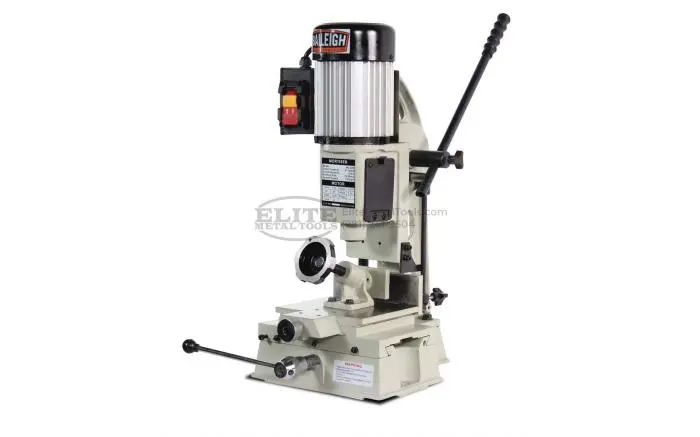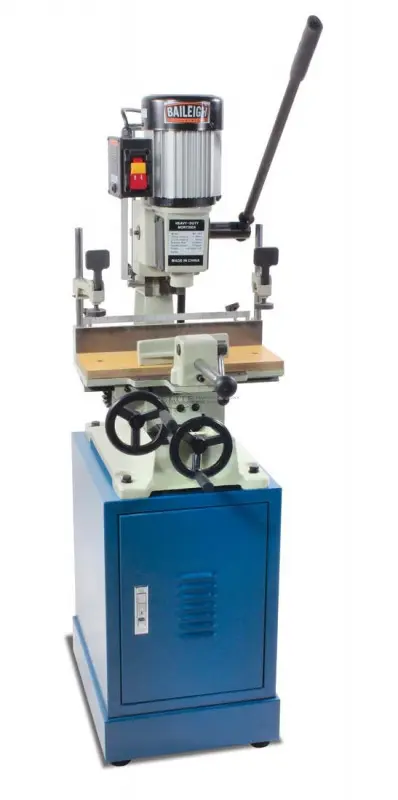Elite Metal Tools Articles
Industry news, tips, and updates on all things Elite Metal Tools
Mortisers - Let's Learn About
The Complete Guide to Mortisers: Exploring Innovations in Woodworking Technology
Introduction
Woodworking has witnessed significant advancements over the centuries, with modern machinery revolutionizing the industry. Among these tools, the mortiser stands out as an essential machine for creating precise and sturdy joints in woodworking projects. In this comprehensive guide, we will delve into the history of mortisers and explore the different types available in the market. We'll also discuss how to choose the right mortiser, safety tips for usage, and the importance of maintenance and care. Additionally, we will investigate the latest innovations in mortiser technology, including the integration of pneumatic systems. Whether you're a seasoned woodworker or a beginner, this article will serve as an indispensable resource for your woodworking journey.
The History of Mortisers
The concept of the mortise and tenon joint can be traced back to ancient civilizations, where skilled artisans used chisels and mallets to create these joints by hand. As woodworking evolved, the need for more efficient and accurate methods led to the development of the first mechanized mortisers during the 19th century. Early mortisers were powered by hand or foot and were limited in terms of speed and precision.
The industrial revolution saw significant advancements in woodworking machinery, and by the late 1800s, steam-powered mortisers became prevalent in large-scale production. As technology continued to progress, electric-powered mortisers emerged, providing woodworkers with faster and more reliable options for creating mortises. Today, modern mortisers utilize innovative technologies like pneumatic systems and digital controls, making them indispensable tools in woodworking workshops worldwide.
Types of Mortisers
Mortisers come in various types, each tailored to different woodworking needs:
a. Benchtop Mortisers: Ideal for small to medium-sized woodworking projects, benchtop mortisers are compact and portable, making them suitable for hobbyists and those with limited workshop space./product/838
b. Floor-standing Mortisers: These robust machines are designed for heavy-duty woodworking tasks. They provide superior stability and power, making them the go-to choice for professional woodworkers and large-scale production./product/839
c. Hand-held Mortisers: Portable and versatile, hand-held mortisers are perfect for on-site woodworking or when precision mortising is required in tight spaces.
Choosing the Right Mortiser
Selecting the appropriate mortiser for your woodworking needs is crucial to achieving optimal results:
a. Project Requirements: Identify the scale and complexity of your projects. For small projects or hobbyists, a benchtop mortiser may suffice, while floor-standing mortisers are better suited for professional use and large projects.
b. Power and Speed: The power of the mortiser's motor affects its ability to handle different wood types and thicknesses. Opt for a machine with adjustable speed settings for versatility.
c. Features and Accessories: Look for additional features such as adjustable fences, depth stops, and hold-downs, which contribute to the machine's precision and ease of use.
d. Budget: Determine your budget range and find a mortiser that offers the best balance between quality and affordability.
Tips for Using Mortisers Safely
Safety should always be a top priority when operating any woodworking machinery, including mortisers:
a. Read the Manual: Familiarize yourself with the manufacturer's instructions and safety guidelines provided in the machine's manual.
b. Eye and Ear Protection: Wear safety glasses and ear protection to shield against flying debris and loud noises.
c. ecure Workpiece Properly: Always secure the workpiece firmly in place using clamps or hold-downs to prevent it from shifting during the mortising process.
d. Use Proper Chisels: Ensure that the chisels are sharp and properly installed in the machine. Dull or incorrectly inserted chisels can lead to inaccurate cuts and pose safety risks.
e. Do Test Runs: Before working on your actual project, practice on a scrap piece of wood to familiarize yourself with the mortiser's operation.
Maintenance and Care
Regular maintenance of your mortiser is essential to keep it in peak condition and extend its lifespan:
a. Cleaning: Regularly clean the machine, removing dust and debris from all parts, including the chisel, chuck, and motor.
b. Lubrication: Lubricate moving parts according to the manufacturer's recommendations to reduce friction and ensure smooth operation.
c. Inspection: Inspect belts, pulleys, and electrical components for signs of wear and tear, and replace any damaged parts promptly.
Latest Innovations in Mortiser Technology
In recent years, mortiser technology has witnessed significant advancements, including:
a. Digital Controls and Automation: Manufacturers have integrated digital controls into mortisers, allowing for precise measurements and control over cutting depths. Automation features streamline the mortising process, reducing human error and saving time.
b. Pneumatic Systems: Some modern mortisers utilize pneumatic systems to power the chisel. These systems use compressed air to generate force, providing smoother and more consistent cutting actions.
c. Versatility in Chisel Options: Innovations in chisel design have led to more versatile options for mortisers, enabling compatibility with various chisel types for different woodworking projects.
d. Dust Collection Systems: Advanced mortisers now feature built-in dust collection systems, keeping the work area clean and improving visibility during the mortising process.
e. Augmented Reality (AR) Assistance: AR technology provides real-time assistance during mortising operations, guiding users on correct positioning and depth settings for more intuitive and error-free operation.
f. Improved Safety Features: Latest mortisers may have additional safety features, such as emergency stop buttons, blade guards, and automatic shutdown mechanisms, ensuring a safer working environment.
g. Eco-Friendly Features: Manufacturers are incorporating eco-friendly elements into mortisers, such as energy-efficient motors, sustainable materials, and reduced emissions.
Conclusion
In conclusion, the mortiser is an indispensable tool for woodworking enthusiasts and professionals alike. Understanding the history and evolution of mortisers, the different types available, and the factors to consider when choosing one, will empower woodworkers to make informed decisions. Safety, maintenance, and proper care are vital aspects of owning a mortiser, ensuring both excellent performance and longevity of the machine.
When it comes to investing in a mortiser, brands like Baileigh, Powermatic, and Maksiwa have proven their commitment to quality and innovation, making them reliable choices for woodworkers seeking exceptional results.
With the knowledge gained from this comprehensive guide, woodworkers can confidently embrace the mortiser as a valuable asset in their woodworking arsenal, elevating their craftsmanship to new heights.

